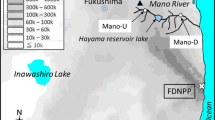Abstract
The dynamics of accumulation and loss of different physico-chemical forms of 106Ru were measured in the euphausiid Meganyctiphanes norvegica. The accumulation of 106Ru was directly related to the concentration of the radioisotope in solution, as evidenced by similar concentration factors for euphausiids in the “low” and “high” activity 106Ru chloride solutions. The chemical form of the radioisotope in solution had a pronounced effect on the uptake, with 106Ru chloride fractions being accumulated at a faster rate than 106Ru nitrosyl-nitrato complexes. Euphausiids lost 106Ru, previously accumulated from the 106Ru chloride complexes, at a faster rate than 106Ru which had been accumulated from 106Ru nitrosyl-nitrato forms. Also, in the case of the 106Ru chloride complexes, the loss rate was inversely proportional to the time allowed for isotope accumulation. The process of molting greatly accelerated the loss of 106Ru from euphausiids, with first molts shed during the loss phase accounting for 70 to 80% of the total 106Ru body burden. When euphausiids accumulated 106Ru from the food chain, the initial-loss rate was rapid due to large amounts of the radioisotope associated with fecal pellets; however, no relationship was found between loss rate and the number of food rations received. Molts from these individuals did not contain 106Ru, thus, loss from euphausiids obtaining this radioisotope through the food chain is mainly due to fecal pellet deposition and other excretion or exchange processes.
Similar content being viewed by others
Literature cited
Ancellin, J. et A. Vilquin: Contaminations expérmentales d'espèces marines par le cérium 144, le ruthénium 106 et le zirconium 95. In: Disposal of radioactive wastes into seas, oceans and surface waters, pp 583–604. Vienna: IAEA 1966.
—: Nouvelles études de contaminations expérimentales d'espèces marines par le césium 137, le ruthénium 106 et le cérium 144. Radioprotection 3, 185–213 (1968).
Auerbach, S. and J. S. Olson: Biological and environmental behaviour of ruthenium and rhodium. In: Radioecology, Proceedings of the First National Symposium, pp 509–519. Ed. by V. Schultz and A. W. Klement, Jr. New York: Reinhold Publ. Corp. 1963.
Crossley, D. A., Jr.: Comparative movement of 106Ru, 60Co, and 137Cs in arthropod food chains. In: Symposium on Radioecology, Proceedings of the Second National Symposium, pp 687–695. Ed. by D. J. Nelson and F. C. Evans. USAEC-CONF-670503 1969.
Dunster, H. J.: The disposal of radioactive liquid wastes into coastal water. In: Proc. 2nd Int. Conf. Peaceful Uses Atomic Energy, U.N., Geneva 18, 390–399 (1958).
Fowler, S. W., L. F. Small and J. M. Dean: Distribution of ingested zinc-65 in the tissues of some marine crustaceans. J. Fish. Res. Bd Can. 27, 1051–1058 (1970).
— and S. Kečkes: Effects of temperature and size on molting of euphausiid crustaceans. Mar. Biol. 11, 45–51 (1971).
Jones, R. F.: The accumulation of nitrosyl-ruthenium by fine particles and marine organisms. Limnol. Oceanogr. 5, 312–325 (1960).
Hiyama, Y. and J. M. Khan: On the concentration factors of radioactive I, Co, Fe and Ru in marine organisms. Rec. oceanogr. Wks Japan 7, 79–106 (1964).
Kečkeš, S., Z. Pučab and Lj. Marazovié: Accumulation of electrodialytically separated physico-chemical forms of Ru-106 by mussels. Int. Jl Oceanol. Limnol. 1, 246–253 (1967).
Kimura, K. and R. Ichikawa: Accumulation and retention of ingested ruthenium-106 by genuine goby. Bull. Jap. Soc. scient. Fish. 35, 434–440 (1969).
—: Uptake of ruthenium-106 by short-necked clam. Bull. Jap. Soc. scient. Fish. 36, 653–660 (1970).
Lowman, F. G.: Marine biological investigations at the Eniwetok Test Site. In: Disposal of radioactive wastes 2. Vienna: IAEA 1960.
Marazović, Lj. and Z. Pučab: Two-dimensional electrochromatography of 106ruthenium and some other radiomicroconstituents in sea water. J. Chromat. 27, 450–459 (1967).
Mauchline, J. and W. L. Templeton: Artificial and natural radioisotopes in the marine environment. Oceanogr. mar. Biol. A. Rev. 2, 229–279 (1964).
Osterberg, C.: Fallout radionuclides in euphausiids. Science, N.Y. 138, 529–530 (1962).
—, L. F. Small and L. Hubbard: Radioactivity in large marine plankton as a function of surface area. Nature, Lond. 197, 883–884 (1963).
Polikarpov, G. G.: Radioecology of aquatic organisms, 314 pp. Amsterdam: North-Holland 1966.
Saiki, M. T. Koyanagi and M. Ishikawa: Concentration of radionuclides by clam from sea water with 85Sr chloride, 106Ru chloride and 106Ru nitrosyl complex. Rep. natn. Inst. Radiolog. Sci. (NIRS-7) 93–94 (1967).
Tsuruga, H.: The uptake radioruthenium by several kinds of littoral seaweed. Bull. Jap. Soc. scient. Fish. 28, 1149–1154 (1962).
Van der Bobght, O. and S. Van Puymbroeck: Initial uptake, distribution and loss of soluble 106Ru in marine and freshwater organisms in laboratory conditions. Hlth Phys. 19, 801–811 (1970).
Author information
Authors and Affiliations
Additional information
Communicated by J. M. Peres, Marseille
Rights and permissions
About this article
Cite this article
Kečkeš, S., Fowler, S.W. & Small, L.F. Flux of different forms of 106Ru through a marine zooplankter. Marine Biology 13, 94–99 (1972). https://doi.org/10.1007/BF00366560
Accepted:
Issue Date:
DOI: https://doi.org/10.1007/BF00366560




